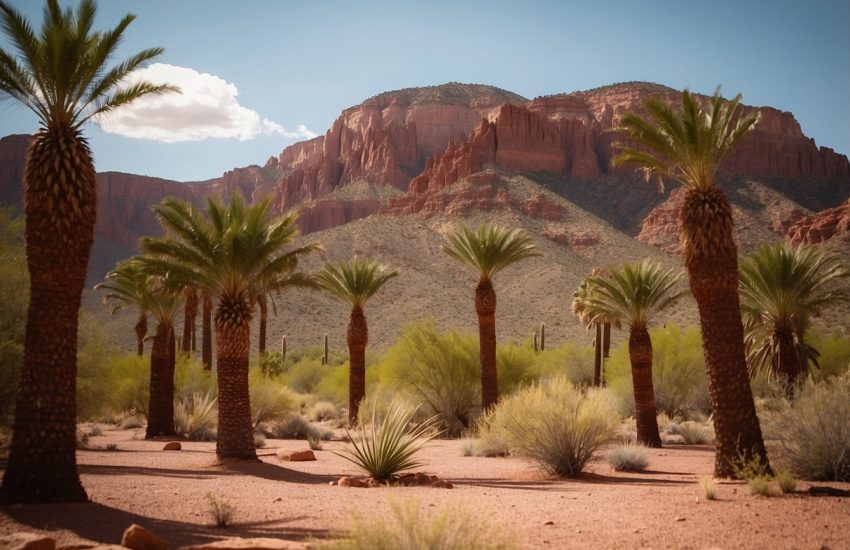Palms for Zone 7: Best Options for Your Garden
Zone 7 is a challenging region for growing palm trees due to its cold winters and hot summers. However, with the right selection of cold-hardy palms, it is possible to create a tropical oasis in this region. Palms are known for their elegant appearance, and they come in a variety of shapes and sizes, making them a popular choice for landscaping.

When it comes to selecting palms for Zone 7, it is essential to choose cold-hardy varieties that can withstand the region’s harsh winter conditions. Some cold-hardy palm trees that can thrive in Zone 7 include the Needle Palm, Windmill Palm, and Chinese Windmill Palm. These palm trees can tolerate freezing temperatures and are known for their resilience and hardiness.
In this article, we will explore some of the best palms for Zone 7 and provide tips on how to grow and care for them. Whether you are looking to create a tropical paradise in your backyard or add some exotic flair to your garden, this guide will help you choose the right palms for your needs.
Selecting Palms for Zone 7
When it comes to selecting palms for Zone 7, it is important to consider the climate, hardiness zone, and the specific needs of each palm tree. This section will cover the key factors to consider when selecting palms for Zone 7, including understanding the climate, top cold hardy palms for Zone 7, and palm tree care in Zone 7.
Understanding Zone 7 Climates
Zone 7 is characterized by cold winters and hot summers, with average winter temperatures ranging from 0 to 10 degrees Fahrenheit. It is important to note that Zone 7 can also have microclimates, which can affect the growth and survival of palm trees. Microclimates are small areas within a larger climate zone that have slightly different temperatures, moisture levels, and other environmental factors.
Top Cold Hardy Palms for Zone 7
When it comes to cold hardy palm trees for Zone 7, there are several options to choose from. The Windmill Palm (Trachycarpus fortunei) is a popular choice, as it can withstand temperatures as low as 10 degrees Fahrenheit and is recommended for Zones 7B-11. The Needle Palm (Rhapidophyllum hystrix) is considered the cold hardiest palm tree in the world and can tolerate freezing temperatures down to -10 degrees Fahrenheit. Other cold hardy palms for Zone 7 include the Pindo Palm (Butia capitata), Dwarf Palmetto (Sabal minor), European Fan Palm (Chamaerops humilis), and Sabal Palmetto (Sabal palmetto).
Palm Tree Care in Zone 7
Proper care is essential for the growth and survival of palm trees in Zone 7. When planting palm trees, it is important to choose a sheltered area that is protected from strong winds and frost. Palm trees also require well-draining soil and regular watering, especially during the hot summer months. Mulching around the base of the tree can help retain moisture and regulate soil temperature. Pruning dead or damaged fronds can also help promote healthy growth.
In terms of sun exposure, most palm trees prefer full sun, but some can tolerate partial shade. Drought-tolerant palm trees, such as the Mexican Fan Palm (Washingtonia robusta) and California Fan Palm (Washingtonia filifera), are good options for Zone 7 gardens. It is important to note that some palm trees may require additional protection during the winter months, such as wrapping the trunk with burlap or providing a heat source.
Overall, selecting the right palm tree for your Zone 7 garden can add a tropical or subtropical touch to your outdoor space. By understanding the climate, choosing a cold hardy palm tree, and providing proper care, you can enjoy the beauty and benefits of these unique and exotic plants.
Designing Landscapes with Palms
Palms are a great addition to any garden landscape. They add a tropical feel and create a sense of relaxation. With their variety of sizes, shapes, and colors, palms can be used in a variety of ways to create a unique and beautiful landscape. In this section, we will explore how to design landscapes with palms.
Creating Microclimates for Palms
Palms are tropical plants and require warm temperatures to thrive. However, some palm tree varieties are cold-hardy and can survive in Zone 7 climates. To ensure that palms thrive in colder climates, it is essential to create microclimates. Microclimates are small areas within a garden that have specific environmental conditions. By creating microclimates, gardeners can provide sheltered areas for palms to grow.
Palms with feather-like fronds, such as the Queen Palm and the Areca Palm, are great for creating a tropical landscape. They add a sense of elegance and beauty to any garden. However, feather-like fronds are susceptible to wind damage. Therefore, it is essential to plant these palms in sheltered areas.
Palms with Decorative Features
Palms have unique decorative features that can add interest to any garden. For example, some palm tree varieties have fan-shaped fronds that create a tropical atmosphere. The Windmill Palm, for example, has fan-shaped fronds that add a sense of elegance to any garden.
Some palm tree varieties also produce edible fruit. The Coconut Palm is a classic example of a palm that produces edible fruit. The fruit is not only delicious but also adds interest to any garden. The Date Palm is another example of a palm that produces edible fruit. The fruit is used in many Middle Eastern dishes and is a great addition to any xeriscaping garden.
Palms also have unique trunks that add interest to any garden. The Bottle Palm, for example, has a unique bottle-shaped trunk that creates a sense of whimsy. The Royal Palm has a smooth trunk that is perfect for creating a tropical landscape.
In conclusion, designing landscapes with palms requires a careful consideration of the environment and the palm tree varieties. By creating microclimates and planting palms with decorative features, gardeners can create a unique and beautiful landscape.


